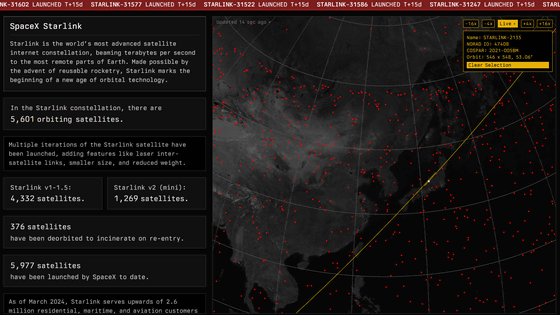One to two Starlink satellites fall to Earth every day.

The satellite internet service 'Starlink' uses a constellation of over 5,000 satellites to provide its services. These satellites have a five-year lifespan, and the satellites launched in 2019 are reaching the end of their lifespan one after another, and are being disposed of by re-entering the atmosphere. Recently, it seems that satellites are being re-entered at a rate of one to two per day.
1 to 2 Starlink satellites are falling back to Earth each day
You can check how many Starlink satellites have been launched and where they are flying at 'STARLINKMAP.ORG'.
'STARLINKMAP.ORG' shows in real time where Starlink satellites are flying right now - GIGAZINE

Astrophysicist Jonathan McDowell also compiles and publishes Starlink satellite operation status on his website.
Jonathan's Space Report | Space Statistics
According to McDowell's statistics, Starlink has launched more than 9,000 satellites to date. Of these, 3,306 first-generation satellites and 4,177 second-generation satellites are currently in orbit and operational. The first-generation satellites were launched in 2019 and have a design lifespan of about five to seven years, and are being gradually disposed of.
In many cases, satellite re-entry can be observed from the ground, with the most recent example being the re-entry of a Starlink satellite in California in September 2025.
WATCH: Starlink debris seen over the skies of Sacramento County, California.
— AZ Intel ( @azintel.bsky.social ) September 26, 2025 12:37
[image or embed]
The following video shows a Starlink satellite re-entering the orbit, apparently captured by the University of Western Ontario in Canada. It appears to be a different satellite than the one seen in California.
Here's the official Global Meteor Network camera video from Lucky Lake, Saskatchewan! This video is courtesy University of Western Ontario and Defense R&D Canada.
— Prof. Sam Lawler ( @sundogplanets.mastodon.social.ap.brid.gy ) September 27, 2025 0:53
I counted 13 pieces in the video, how many do we think made it to the ground and are sitting on canola stubble east of Saskatoon?
[image or embed]
It is said that such re-entry of satellites occurs at a rate of one to two per day.
In addition to Starlink, Amazon's Kuiper and other satellites are also launching satellites to provide services, bringing the total number of satellites in low Earth orbit to 30,000. China is also planning to launch 20,000 satellites, and in the future, satellite re-entry rates could increase to five per day.
On the other hand, because China is not necessarily lowering the altitude of its satellites, McDowell points out the risk of a Kessler syndrome, in which satellites collide with each other, creating debris, which in turn creates more debris.
The Starlink service is available for 4,600 yen per month for the Home LITE plan and 6,600 yen per month for the Home plan.
Starlink | Home
https://www.starlink.com/jp/residential
The starter kit was sold on Amazon for 53,800 yen including tax.
Amazon | Starlink Standard Kit | Starlink | Wireless and Wired LAN Routers

It can also be purchased at Costco.

Related Posts:







